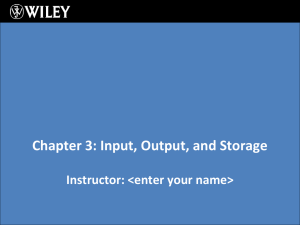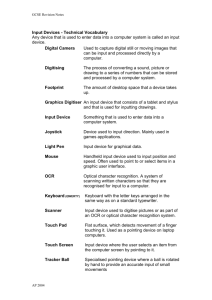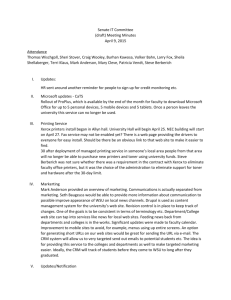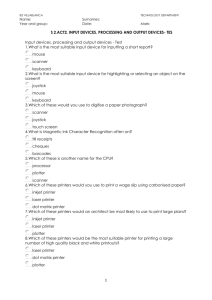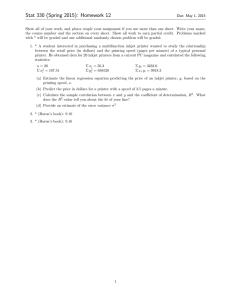Update_Chapter_3
advertisement
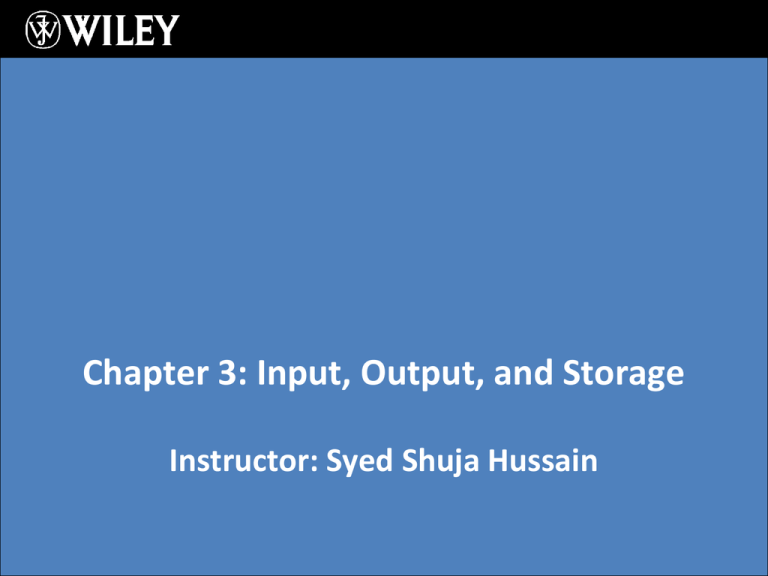
Chapter 3: Input, Output, and Storage Instructor: Syed Shuja Hussain Keyboards QWERTY layout Function keys Toggle keys Modifier keys Positional keys Specialty Keyboards Wireless Bluetooth Infrared Ergonomic Bilingual Virtual Pointing Devices Mouse Mechanical (ball) or optical Corded or cordless Trackball Touchpad Touch screen Joystick Drawing Tablet Inkless pen called a stylus Used for creating digital artwork Sensory Input Devices Global Positioning System (GPS) Accelerometer Compass Gyroscope Scanning Devices Digitizes hard copy Uses a photosensitive charge-coupled device (CCD) Types of scanners Flatbed Document feeder Bar code reader Business card scanner Other Input Devices Magnetic card reader Optical mark recognition (OMR) Magnetic character recognition (MICR) Radio frequency (RF) ID chip Biometric authentication devices Fingerprint scanner Facial recognition software and camera Retina scanner Capture Devices Digital camera Digital video camera Web cam Audio Input Devices Audio adapter (sound card) Microphone Voice recognition software Speech recognition software Display Screens Video screen the computer uses to provide information to a human user Display is made up of individual dots called pixels Current Monitor Technologies Liquid Crystal Display (LCD) Active vs. Passive Matrix Light-Emitting Diode (LED) Organic LED (OLED) E-paper Digital/smart whiteboard Digital projector Cathode Ray Tube (CRT) Older technology, mostly obsolete Large vacuum tube with electron guns that strike phosphors to light up the screen Triads of red, green, and blue phosphors Resolution Measured in horizontal and vertical pixels, such as 1024 x 768 Each display has a maximum (native) resolution LCD and LED displays look best at their native resolution Aspect ratio is ratio of width to height, such as 4:3 or 16:9 Resolution Other Measures of Monitor Performance Refresh rate Number of times per second each pixel is refreshed Mostly an issue on CRTs; insufficient refresh rate can cause flickering Color depth Number of bits required to describe the color of each pixel 32-bit or 16-bit is the norm for most operating systems Display Adapter The hardware that helps the operating system communicate to the monitor what should be displayed May be built into the motherboard or may be a separate circuit board installed on the motherboard If separate, has its own memory Requires a device driver installed in the operating system Printers Factors to Consider: Initial cost Per-page cost (consumables Resolution (dots per inch) Speed Color Paper handling Interface Multiple functions Impact vs. Non-Impact Impact printers strike an inked ribbon to make a mark on the paper Dot matrix printers are still used in industrial settings They print on multi-part forms Impact vs. Non-Impact Non-impact printers lay the ink or toner down on the paper without striking it Inkjet Laser Thermal Plotter Inkjet Printer Sprays liquid ink onto the page Separate ink cartridges: black, cyan, magenta, yellow Some printers can print photos very realistically Initial cost of the printer can be very low Ink is expensive Laser Printer Uses powdered toner Can be color or black-and-white Initial cost is higher than inkjet Cost per page of toner is low Laser Printer Printing Process Drum inside printer is negatively charged A laser partly neutralizes the charge in certain areas Toner clings to the neutralized areas Paper is charged so that toner jumps off onto paper Fuser heats the paper, melting the toner into the paper Comparing Printer Types Dot Matrix Inkjet Laser Initial Cost Medium Inexpensive Expensive Per-page Cost Inexpensive Expensive Inexpensive Resolution Poor Good Good Speed Slow Medium Fast Color No Yes Some models Paper handling Continuous feed Single lowcapacity tray Multiple highcapacity trays (some models) Suitable for Photo printing, Business home use printing, highvolume printing Multi-part forms, textonly printouts Specialty Printers Thermal Direct thermal Thermal wax transfer Thermal dye transfer Plotter Storage Devices Primary storage: memory Secondary storage: disks and solid-state drives Evaluations of storage: Capacity Cost Access speed Interface Media type Portability Removability File Storage Vocabulary File: a named collection of bits that represent a single object Folder: A logical organizing unit for files Volume: A physical storage device or a portion of one that is assigned an identifying letter Drive: A physical storage device, or the mechanical parts that spin a disk so that data can be written and read on it Disk: A spinning platter that holds data Hard Disk Drive (HDD) A mechanical storage drive Consists of a stack of metal platters Read-write heads access the stored data Data is stored in binary form in changes between positive and negative magnetic polarity Hard Disk Drive (HDD) Optical Drives CDs, DVDs, Blu-ray Reads and writes in patterns of greater or lesser reflectivity Types of Discs CD, DVD, Blu-ray Read-only, write-once, or rewriteable Single-sided or double-sided Single-layer, double-layer Types of Discs Solid-State Drives Use a form of EEPROM (memory) to store data Small, removable drives like USB flash drives are portable Large solid state drives designed to replace the hard disk drive are solid-state hard drives (SSHD) Network Storage Vocabulary Direct-attached storage: Local storage, connected directly to the computer Network-attached storage: Storage accessed via a network NAS appliance: A specialize device that provides storage space to network users Storage-area network: Network-accessed storage that appears to the user as local storage RAID Redundant Array of Inexpensive Disks RAID0: Striping for performance RAID1: Mirroring for data security RAID5: Striping with parity, for both performance and data security Cloud Storage Cloud: A secure computing environment accessed online Cloud storage: Storage that is accessed from a cloud environment

